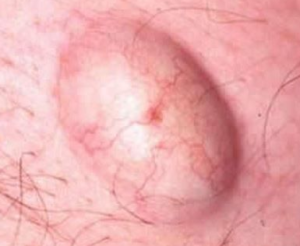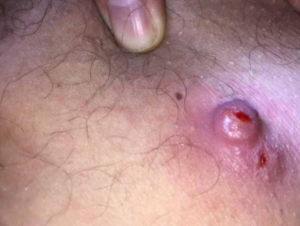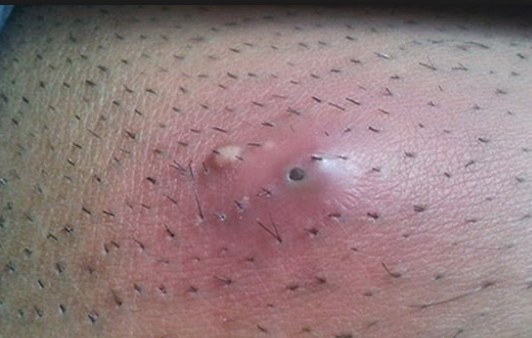Ingrown hair are those hairs that have curled around and grown back into the skin. The hair blocks the skin pores which then accumulate pus, dirt and dead skin cells to form ingrown hair lump, bump or cyst. These bumps can occur on any part of the body. They are common under the skin, in the neck, armpit, and in the groin.
Ingrown hair cyst or bumps are common and harmless and will in most cases require no treatment to get rid of them. They can, however, be painful, itchy, and irritating when infected. This can be both annoying and discomforting.

Ingrown hair lump under skin female
Ingrown hair lump under skin as mentioned is common in both males and females. In grown hair under skin are known to produce red raised bump that can be itchy and painful especially when infected. When infected, they become very painful and in most cases filled with foul smelling pus.
Depending on where they occur on the skin of a female, ingrown hair bumps can annoying and embarrassing at the sometime. So what causes ingrown hair cyst in females and how can you get rid of them?
Just like in males, shaving is the major cause of these bumps. After shaving, especially for those females with course or Curly hair, the hair strand may curl and reenter the skin forming and ingrown hair. In rare cases, the hair may curl back into the hair follicle without exiting the skin. This can be shown as raised bumps under the skin.
Apart from shaving ingrown hair lump in females can be as a result of blocked hair follicles. This can occur when the hair follicles become clogged with dirt, dead skin cells and excess sebum production by the sebaceous glands.
The blocked hair follicle may force the hair strands to grow sideways forming ingrown hair. This common in people with curly hair or those that shave often.
In both males and female, adopting a different hair removal may help prevent the formation of ingrown hair bumps on skin, groin, armpits and other parts of the body.
Ingrown hair lump groin
Ingrown hair bumps in groin can in most cases be confused for something serious. Most people find it hard to differentiate ingrown hair bump from those caused by sexually transmitted infection or common skin disorders such as genital psoriasis.
While grown hair are harmless, other bumps that appear on grown might be a sign of some serious underlying condition that requires urgent medical attention. Have your doctor examine the lumps to rule out serious conditions.
Ingrown hair lump on neck
On neck, ingrown hair lumps are often as a result of poor shaving and other methods of hair removal. The lumps can also be caused by poor hygiene which leads to the clogging of skin pores. This makes it hard for the hair strand to penetrate the skin and as such grows sideways underneath the skin causing the formation of an ingrown hair.
Ingrown hair bump on neck can also be caused by skin irritation from wearing irritating clothes. Just like those on other parts, ingrown hair on neck are harmless and require no treatment. Maintain proper hygiene and proper hair removal method is all you need to prevent these bumps.
Ingrown hair lump armpit
Armpits are common site of ingrown hair formation. Poor hygiene, shaving method, and skin irritation are some of the common cause of these bumps.
Ingrown hair bump in armpits can be irritating and annoying just like those in other parts of the body. Don’t pop or drain the cyst at home as you increase the chances of picking up an infection.
Ingrown hair lump bikini line, pubic area
Clogged bikini line or wearing tight and ill-fitting clothes that irritate the skin is one of the major cause of ingrown hair bump in this area.
Like ingrown hair on other parts of the body, those on biking line can be annoying and embarrassing to have. These lumps can be detrimental to your self-esteem especially when in public.
Avoiding things that irritate the skin is one of the ways you can try and avoid the formation of this bumps.
Ingrown hair cyst groin
As mentioned, an ingrown hair can occur on any part of the body. Ingrown hair cyst in groin can be deep thus causing you allot of pain and discomfort. An ingrown hair will often turn into a boil or abscess once infected.
An ingrown hair cyst in groin is simply a hair follicle cyst. There are close similarities between a normal cyst and an ingrown hair cyst which makes it hard for most people to differentiate the two. While normal cyst are caused by the clogging and accumulation of dead skin cell and puss in the hair follicles, ingrown hair cyst in grown and other parts of the body are formed in the same way, the difference is these cysts have a hair strand embedded inside the cyst.
An ingrown hair cyst can be felt as a hard lump. In rare cases, the cyst may become painful and irritating especially when infected. The major cause of this cyst is shaving, and are very common in people with natural course or curly hair.
Hard ingrown hair lump
Ingrown hair are known to produce raised bumps that can be annoying and irritating. In some people, ingrown hair can form hard painful bumps that resemble boils. These bumps can be itchy and uncomfortable especially when occurring on face and around the genital area.
Regardless of what symptoms the ingrown hair has, you should leave them for a while. Remember, though they might be irritating, ingrown hair are harmless and will in most case clear on their own without treatment.
Don’t pick or scratch hard ingrown hair lump regardless of where on the body the bump occurs. Popping or draining an ingrown hair bump increases the chances of picking up an infection. When infected, the lump can become more irritating and painful.
Huge ingrown hair bump
The appearance of an ingrown hair cyst will vary from one person to the other. Huge ingrown hair bump often indicates a possible underlying infection. The infection causing the bumps to grow this huge can be either bacterial or fungal.

An ingrown hair can get infected as a result of picking, draining or popping the bump at home. An inflamed and infected ingrown hair bump is known as folliculitis and occurs when the hair follicle becomes inflamed and filled with dead skin cells and pus.
According to the National Health Services UK, huge pus filled ingrown hair does not always indicate an infection. They add that mild cases of folliculitis can clear on their own. On your part, you need to try not to shave for a few days to see if the condition gets better.
At home, you can try dabbing a mild antiseptic on the huge ingrown hair. Natural antiseptics you can try include tea tree oil, and apple cider vinegar. If the bump fails to improve within a day or two, please have a dermatologist look at it as soon as possible.
Your doctor may prescribe some oral or topical antibiotics. In some cases, the huge ingrown hair bump may be drained or surgically removed.
Ingrown hair bump won’t go away
Most skin cysts are harmless and painless and will in most cases clear without treatment. An ingrown hair bump that won’t go away is often the first sign of an infection. When infected, an ingrown hair can turn into a boil or abscess. The cyst can then become very painful, itchy and irritating. In most cases, an infected ingrown hair lump or bump may fail to go away or keeps coming back.
Though most cyst requires no treatment to get rid of them, an infected cyst or that which to go away may require urgent and proper medical diagnosis. Though rare, this could also be a sign of cancer. This may make the lump dangerous as the infected cells may start invading or spreading to healthy cells.
Have a dermatologist or your general health practitioner examine the lump. Your doctor will perform a biopsy to confirm whether or not the lump is cancerous. If diagnosed with cancer, there are different treatment options available to help treat the condition.
Depending on the type and stage of cancer, your doctor may prescribe:
- a surgery, where the cancerous cells are completely removed
- chemotherapy which uses strong chemical medicine or
- radiation therapy where strong ultra-violate rays are used to destroy the cancerous cells
Ingrown hair lump, bump and cyst treatment
Proper treatment of ingrown hair lump, bump or cyst will in most cases depend on what symptoms are shown by the cyst. The treatment will also depend on what the underlying cause of the bump is.
Steroid creams and anti-inflammatory creams are used to treat large, swollen ingrown hair bumps. For infected ingrown hair, treatment will vary with the kind of infection. Oral and topical antibiotics are used for bacterial infection.
Ingrown hair cyst caused by cystic acne is treated with anti-acne medication, anti-acne medication contains salicylic acid that helps treat the ingrown hair cysts.
You need to see you doctor the cyst or lump keeps grown large, fails to go away or keeps coming bump. In rare cases, an ingrown hair lump may be cancerous. In such case, urgent and proper medical treatment will be required to try and reduce the chances of the cancerous cells invading healthy cells.
Ingrown hair bump cream
With ingrown hair bumps especially around the pubic area, there are some creams you can use to relieve these symptoms. Your dermatologist will in such cases prescribe a topical anti-inflammatory cream such as steroid cream. Topical steroid cream can help reduce swelling and irritation around the ingrown hair bump.
The other cream your doctor can prescribe is retinoid creams. These creams can speed up the clearing of dead skin cells that might clog the hair follicles leading to the formation of ingrown hair lumps. Retinoid creams are also good in clearing the dark spots caused by an ingrown hair.
A common side effect of most of these cream is that it can cause dry skin especially for those with sensitive skin. Pregnancy women should not use medicine with retinoid. According to health line, these medications can be dangerous to the baby and in some case, it could lead to birth defects.
Ingrown hair cyst home treatment
No treatment is required to treat ingrown hair in most cases. However, there are some simple methods apply at home to try and relieve the pain, itching, and irritation caused by the ingrown hair bump.
Some of the simple remedies you can try to treat ingrown hair at home include the following:
1. Applying a simple warm compress
At home, you can use a simple warm compress to relieve the symptoms caused by the ingrown hair bump. A warm compress can help relieve the pain, itching, irritation, and swelling of the bump.
What you need to do is gently rub a warm washcloth around the huge ingrown hair bump. A hot compress will also help speed up the healing of an infected ingrown hair cyst.
2. Exfoliating to remove dead skin cells
Removing dead skin cells may help return the hair to the surface of the skin. If natural exfoliation fails to work, then you dermatologist may prescribe a drug that can help slough off the dead skin cell quickly.
3. Aloe Vera gel
Aloe Vera is one of those great remedies you can try at home. Aloe Vera gel is rich in antibacterial, antiseptic, anti-inflammatory and anti-itching properties. This makes the gel among the most effective home remedy you can use for different skin conditions.
To use aloe Vera gel for the ingrown hair bump:
- Collect the gel for a fresh aloe Vera leaves
- gently apply the gel around the ingrown hair bump to relieve itching, swelling and irritation
- Don’t pop or drain the bump
4. Tea tree oil
Tea tree oil is also a great remedy you can use at home to get rid of ingrown hair bumps. This remedy is a natural antibiotic, with that, it can help prevent the ingrown hair bump from bacterial infection.
To use this remedy:
- dilute moderate amounts of tea tree oil
- Using a clean cotton ball, gently apply the dilute tea tree oil around the ingrown hair cyst, lump or bump
- you will need to do this twice or thrice to increase its effectiveness
- Don’t use this remedy if you have a sensitive skin. The oil can burn and irritate your skin.
How to prevent ingrown hair lump
Instead of waiting to treat an ingrown hair cyst, they are simple way you can prevent the formation of these bumps in the first place. According to the national health services united kingdom, the simplest way to prevent an ingrown hair is to let the hair grow.
Yes, given that improper hair removal method is what contributes to the formation of ingrown hair, not shaving can be a sure way to avoid the bumps from forming. If you cannot do that, then you could try the following:
- Adopting a proper hair removal method, if you were shaving try waxing or threading
- other you can try to include depilatory creams, electrolysis, and laser removal methods
- when shaving make sure to use a sharp, single bladed razor
- it is recommended to wet your skin before shaving
- on face, legs, and around the genital use as fewer strokes of razor as possible
- avoid shaving too close to the skin
- always shave in the direction of growth of the hair
- do not pop or try to drain the razor bumps at home
References
- http://www.nhs.uk/Conditions/ingrown-hairs/Pages/Introduction.aspx#Causes
- http://www.treatcurefast.com/cysts/ingrown-hair-cyst/ingrown-hair-cyst-removal-deep-infected-pictures-how-to-get-rid-follicle-cysts/
- http://www.healthline.com/health/treating-preventing-ingrown-vaginal-hair
- http://www.webmd.com/skin-problems-and-treatments/guide/ingrown-hair-causes-symptoms-treatment#2
- http://www.treatcurefast.com/hair/pubic-ingrown-hair/ingrown-pubic-hair-infected-cyst-bump-get-rid-treat-remove-prevent-pubic-area-ingrown-hair-boil/
